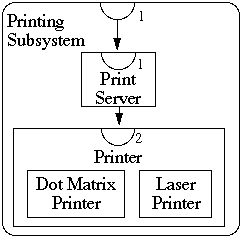 CS 696: Advanced OO
CS 696: Advanced OO
Spring Semester, 1997
Doc 20, Facade and Proxy
To Lecture Notes Index
San Diego State University -- This page last updated May 1, 1997
Contents of Doc 20, Facade and Proxy
| Facade | slide # 1 |
| ...Review of Wirfs-Brock (CRC
Design Process) | slide # 1 |
| ......Exploratory Phase | slide # 2 |
| ......Analysis Phase | slide # 3 |
| ......Subsystems | slide # 4 |
| ...The Facade Pattern - Basic Idea | slide # 5 |
| ...Consequences of Facade Pattern | slide # 5 |
| |
| Proxy | slide # 6 |
| ...Reasons for Object Proxies | slide # 6 |
References
Designing Object-Oriented Software,Wirfs-Brock
Design Patterns: Elements of Resuable Object-Oriented Software, Gamma, Helm,
Johnson, Vlissides, Addison-Wesley, 1995
Facade
Review of Wirfs-Brock (CRC Design Process)
- Who is on the team?
- What are their tasks, responsibilities?
- Who works with whom?
- Who's related to whom?
- Finding sub teams
- Putting it all together
Exploratory Phase
- What are the goals of the system?
- What must the system accomplish?
- What objects are required to model the system and
accomplish the goals?
- What are their tasks, responsibilities?
- What does each object have to know in order to
accomplish each goal it is involved with?
- What steps toward accomplishing each goal is it
responsible for?
- With whom will each object collaborate in order to
accomplish each of its responsibilities?
- What is the nature of the objects' collaboration
Analysis Phase
- Determine which classes are related via inheritance
- Finding abstract classes
- Determine class contracts
- Divide responsibilities into subsystems
- Designing interfaces of subsystems and classes
- Construct protocols for each class
- Produce a design specification for each class and
subsystem
- Write a design specification for each contract
Subsystems
Subsystems are groups of classes, or groups of classes and
other subsystems, that collaborate among themselves to
support a set of contracts
There is no conceptual difference between the responsibilities
of a class and a subsystem of classes
The difference between a class and subsystem of classes is a
matter of scale
A subsystem should be a good abstraction
There should be as little communication between different
subsystems as possible

The Facade Pattern - Basic Idea
Create a class that is the interface to the subsystem
Clients interface with the Facade class to deal with the
subsystem
Consequences of Facade Pattern
It hides the implementation of the subsystem from clients
Differences from Mediator
Facade does not add any functionality, Mediator does
Subsystem components are not aware of Facade
Mediator's colleagues are aware of Mediator and interact with
it
Proxy
proxy n. pl prox-ies The agency for a person who acts as a
substitute for another person, authority to act for another
Reasons for Object Proxies
Remote Proxy
- The actual object is on a remote machine (remote address
space)
- Hide real details of accessing the object
- Used in CORBA
Virtual Proxy
- Creates/accesses expensive objects on demand
- You may wish to delay creating an expensive object until it
is really accessed
- It may be too expensive to keep entire state of the object
in memory at one time
Protection Proxy
- Provides different objects different level of access to
original object
Smart Reference
- Delete original object when there are no references to it
- Lock original object so no other object can modify original
- Load persistent object into memory when first referenced
The Pattern
The proxy has the same interface as the original object
Use common interface (or abstract class) for both the proxy
and original object
Proxy contains a reference to original object, so proxy can
forward requests to the original object
Proxy verses Other Patterns
Decorator
- Decorators add responsibility(ies) to an object
- Proxies controls access an object
Chain of Responsibility
- Chain can contain many objects
- In the chain different objects can perform various
requests
- Proxy forwards (or not) requests to the original object
Facade
- A facade represents a system of objects
- A proxy represents a single object
- A facade simplifies the interact between client and the
system
- A proxy controls the access to the single object
Observation
All the design patterns in the text are based on:
- programming to an interface
- using indirection (composition )
These two elements are used to construct communicating
objects and classes that solve a general design problem in a
particular context
The structures of different patterns may be similar but the
problem each pattern solves is different
Different pattern's problems may overlay at times
The goal is not to produce a disjoint taxonomy of structures
but a list of common problems and a general structure for
solving them

 CS 696: Advanced OO
CS 696: Advanced OO CS 696: Advanced OO
CS 696: Advanced OO